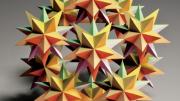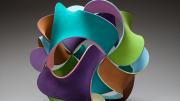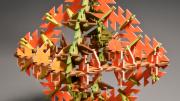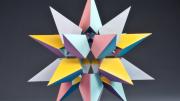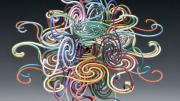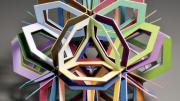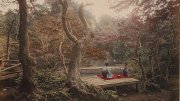Morton C. Bradley Jr. ’33, G ’40, had family ties, extending back to great-grandfather Theophilus Wylie, to Indiana University. But the campus community where he spent nearly all of his life was Cambridge, not Bloomington. The Harvard where he was educated had since the 1870s featured pioneering studies in experimental psychology and the physiology of perception (stemming from William James and Hugo Münsterberg) and the fine arts (Charles Eliot Norton), and in ensuing decades the flowering of logic in philosophy (in the persons of Josiah Royce and the towering figures, then still in the other Cambridge, of Alfred North Whitehead and Bertrand Russell). The strands of formalist aesthetics, of the Bauhaus at Harvard, of music and mathematics and still other influences, are teased out in the essay, “Morton Bradley: An American Formalist,” by Lynn Gamwell, who is also responsible for the volume Color and Form: The Geometric Sculptures of Morton C. Bradley Jr. (Indiana University Art Museum/Indiana University Press, $30).
Bradley (1912-2004) bequeathed his suspended geometric sculptures and associated studies to IU—hence the origins of this publication. He worked for years in the Fogg Art Museum’s conservation department, and published a manual for conservators, The Treatment of Pictures (1950), that is still in use. Bradley began making lithograph prints of geometric forms in 1948, and progressively developed his own system of colors. In the 1960s, he applied them to three-dimensional works, exacting in their geometry and use of color principles, initially in solid planes and then in open wire structures.
Gamwell places the work in the context of the Swiss Constructivists, French Optical art, and American algorithmic art developed by Ellsworth Kelly and Sol LeWitt. Bradley’s sculpture, she says, “embodies the mathematical structure of nature and the beauty of pure mathematics. As such, his work presents us with a classical ideal that is as appealing today as when Plato wrote in the fourth century b.c.: ‘I do not mean by beauty of form such beauty as that of animals or pictures…but straight lines and circles, and the plain and solid figures that are formed out of them by turning-lathes and rules and measures of angles; for these I affirm to be not only relatively beautiful like other things, but they are eternally and absolutely beautiful.’”
Or as Harvard’s Eric Heller, Lawrence professor of chemistry and professor of physics (see “Quantum Art,” January-February 2001, page 36), notes in a foreword, “Mathematicians ‘see’ patterns of numbers and geometric forms in the mind’s eye. One mathematical object is elegant and beautiful, while another might be an ugly, brute-force proof. Scientists like myself study mathematical patterns that are embodied in the natural world, and these structures also have aesthetic qualities, such as the symmetrical pattern of flowing electrons or the dynamism of an ocean wave.” Calling Bradley a “pioneer in visualizing mathematical patterns,” Heller writes, “This beautiful book is a tribute to an artist who made mathematical patterns visible, and, in looking at his colorful, symmetrical sculptures, we better appreciate abstract ideas.”
